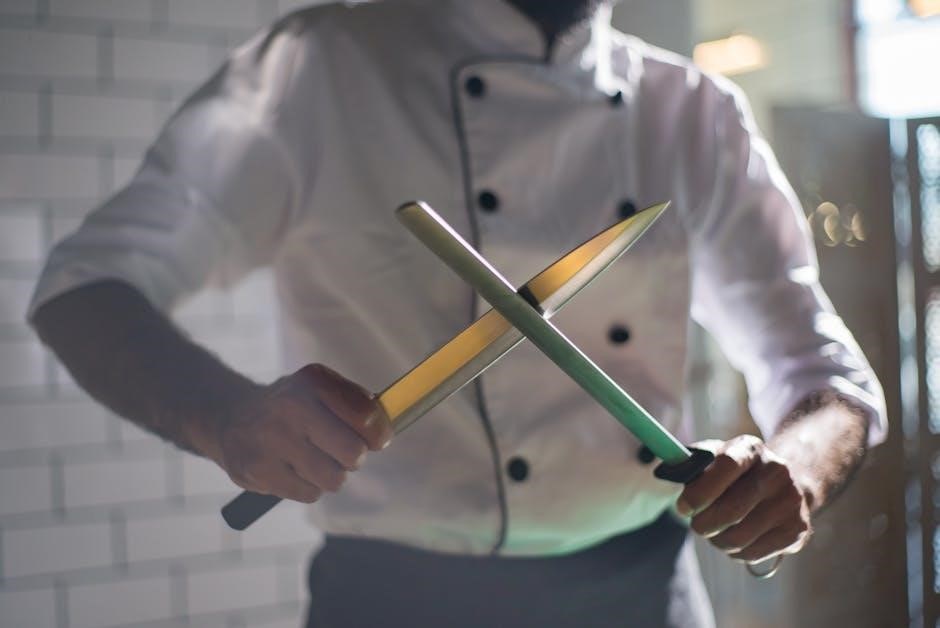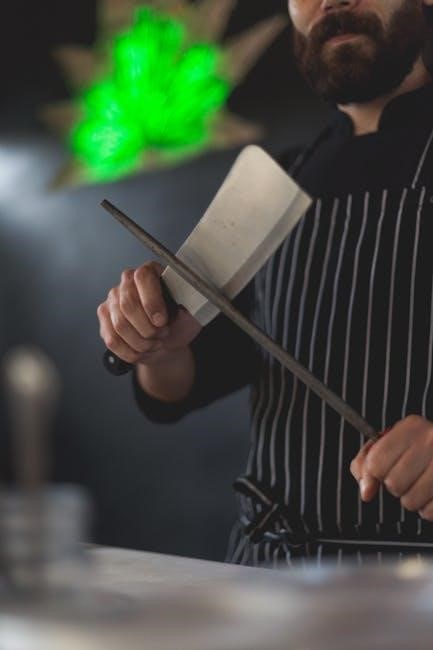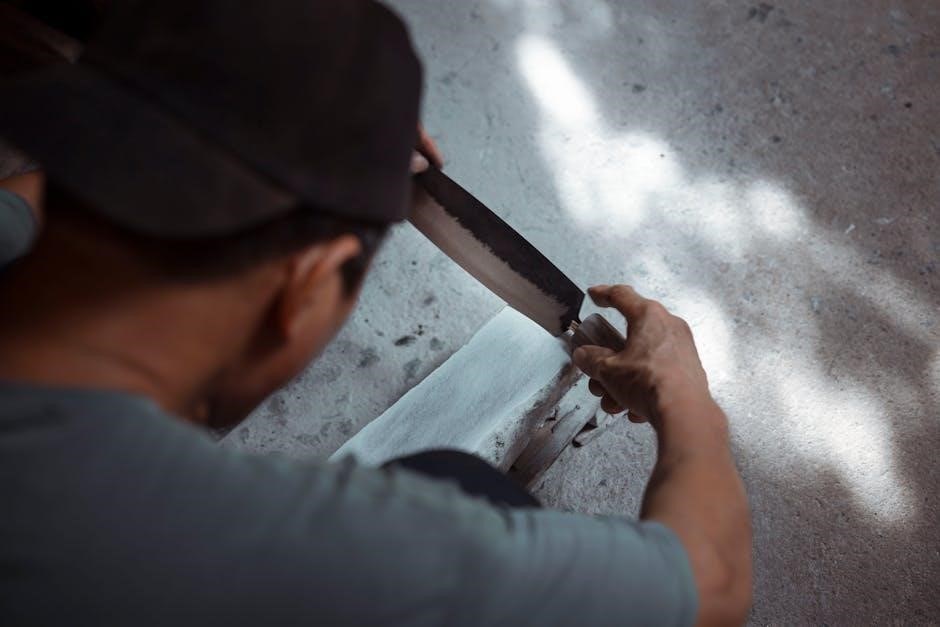Sharpening knives requires patience and skill, using
proper techniques
and equipment for optimal results, with a good knife guide for sharpening being essential, providing a clear and concise introduction to the process always.
Importance of Sharpening Angle
The sharpening angle is a crucial aspect of knife sharpening, as it directly affects the knife’s performance and longevity. A proper sharpening angle ensures a sharp edge, while an incorrect angle can lead to a dull or damaged blade. The angle at which a knife is sharpened depends on the type of knife and its intended use, with different angles suited for various tasks. For instance, a chef’s knife may require a smaller angle, while a hunting knife may require a larger one. Understanding the importance of sharpening angle is essential for achieving optimal results and maintaining the knife’s quality. By recognizing the significance of this aspect, individuals can take the necessary steps to ensure their knives are sharpened correctly, thereby extending their lifespan and improving their overall performance. This knowledge is vital for anyone seeking to master the art of knife sharpening and make the most of their knives.
Understanding Knife Types and Purposes
Recognizing the various types of knives and their intended purposes is essential for effective sharpening. Different knives are designed for specific tasks, such as chopping, slicing, or hunting, and each requires a unique approach to sharpening. For example, a chef’s knife is typically used for chopping and slicing, while a hunting knife is used for skinning and cutting. Understanding the distinct characteristics and requirements of each knife type allows individuals to tailor their sharpening techniques accordingly. By considering the knife’s purpose and design, sharpening can be optimized to achieve the best possible results. This knowledge enables individuals to select the most suitable sharpening methods and tools for their specific knives, ultimately leading to improved performance and extended lifespan. Furthermore, understanding knife types and purposes helps to prevent damage and ensures that the sharpening process is safe and efficient. This foundational knowledge is crucial for anyone seeking to master the art of knife sharpening.

Preparing for Sharpening
Sharpening preparation involves gathering equipment and
following proper guidelines
always carefully.
Choosing the Right Sharpening Equipment
To choose the right sharpening equipment, consider the type of knife and its intended use, as well as personal preference and skill level. A whetstone is a popular choice for sharpening knives, and comes in different types, such as water stones and oil stones. Electric sharpeners are also available, and can be a good option for those who want a quick and easy sharpening process. Additionally, sharpening steels and diamond stones can be used to hone and sharpen knives. It is essential to select equipment that is suitable for the knife being sharpened, and to follow the manufacturer’s instructions for use. By choosing the right sharpening equipment, individuals can achieve a sharp and durable edge on their knives, and improve their overall sharpening experience. With the right equipment, sharpening can be a straightforward and effective process, and can help to maintain the quality and performance of the knife.
Applying Honing Oil or Water
Applying honing oil or water is a crucial step in the sharpening process, as it helps to reduce friction and prevent the stone from loading up with metal particles. The type of lubricant used will depend on the type of stone being used, with water stones requiring water and oil stones requiring honing oil. It is essential to apply the lubricant sparingly, as excessive amounts can interfere with the sharpening process. A small amount of oil or water should be applied to the stone, and the knife should be sharpened in a consistent and controlled manner. By using the correct lubricant, individuals can achieve a sharper and more durable edge on their knives. The lubricant also helps to prevent the stone from becoming clogged, allowing for a more efficient sharpening process. Proper application of honing oil or water is essential for achieving optimal results when sharpening a knife. This step is critical in maintaining the quality of the sharpening stone.

Sharpening Techniques
Mastering sharpening techniques requires practice, using a
consistent motion
and maintaining the correct angle for optimal results always.
Determining the Correct Sharpening Angle
To determine the correct sharpening angle, consider the type of knife and its intended use, as different angles are suitable for various tasks, with a general range of 15-25 degrees being common.
The angle can significantly impact the sharpness and durability of the knife, making it essential to choose the right one.
A chef’s knife, for example, typically requires a smaller angle, around 15-18 degrees, while a hunting knife may require a larger angle, around 20-25 degrees.
Using an angle guide can help ensure accuracy and consistency, especially for those new to sharpening.

It is also possible to estimate the angle by using a protractor or other measuring tool, although this may be more challenging.
Ultimately, finding the correct sharpening angle is crucial for achieving optimal results and extending the life of the knife.
By considering these factors and using the right techniques, it is possible to determine the correct sharpening angle and achieve professional-level sharpness at home.
This requires patience and practice, but the end result is well worth the effort, as a sharp knife is essential for many tasks and can make a significant difference in performance and safety.
Using an Angle Guide for Precision
Using an angle guide is an effective way to achieve precision when sharpening a knife, as it helps to maintain a consistent angle throughout the process.
The guide typically attaches to the sharpening stone or steel, providing a clear indication of the desired angle.
This is especially useful for those new to sharpening, as it eliminates the guesswork involved in estimating the angle.
With an angle guide, it is possible to sharpen a knife to a precise angle, which is essential for achieving optimal sharpness and extending the life of the knife.
The guide also helps to prevent uneven sharpening, which can lead to a dull or damaged blade.
By using an angle guide, individuals can ensure that their knife is sharpened to the correct angle, resulting in a sharper and more durable blade.
This level of precision is difficult to achieve without a guide, making it an essential tool for anyone serious about sharpening their knives.
Overall, an angle guide is a valuable tool for achieving precision and consistency when sharpening a knife.

Sharpening Tools and Guides
Various sharpening tools and guides are available, including electric sharpeners and
- manual kits
designed to help achieve a sharp edge always.
Whetstone Preparation and Use
To prepare a whetstone for sharpening, follow the manufacturer’s instructions, as different stones may require unique preparation steps, such as soaking in water or oil, to ensure optimal performance and longevity.
The whetstone is typically used with a sharpening guide to maintain the correct angle and achieve a sharp edge.
A whetstone can be used to sharpen a variety of knives, including stainless steel and high-carbon steel blades, making it a versatile tool for any knife sharpening task.
Proper use and maintenance of the whetstone are essential to extend its lifespan and ensure consistent sharpening results, and regular cleaning and storage can help prevent damage and maintain the stone’s effectiveness.
By following the manufacturer’s instructions and using the whetstone correctly, users can achieve professional-grade sharpening results and keep their knives in optimal condition, and the whetstone will remain a valuable tool in their knife sharpening arsenal.
The whetstone is an essential component of the sharpening process, and its proper preparation and use are critical to achieving a sharp, durable edge on any knife.
Regular use of the whetstone will help develop the skills and techniques necessary to become proficient in knife sharpening, and the whetstone will become an indispensable tool in the process.
Longzon 4-in-1 Knife Sharpener Features and Benefits
The Longzon 4-in-1 Knife Sharpener is a versatile and convenient tool designed to sharpen a wide range of knives, including stainless steel and high-carbon steel blades.
It features a 4-stage sharpening process, allowing users to achieve a sharp, polished edge on their knives.
The sharpener also includes a pair of cut-resistant gloves, providing protection for the user’s hands during the sharpening process.
The Longzon 4-in-1 Knife Sharpener is easy to use and requires minimal maintenance, making it an ideal choice for both novice and experienced knife sharpeners.
Its compact design and lightweight construction allow for easy storage and transportation, making it a great addition to any kitchen or workshop.
The sharpener’s ability to sharpen multiple types of knives, including fruit knives and scissors, makes it a valuable tool for anyone looking to keep their blades in optimal condition.
Overall, the Longzon 4-in-1 Knife Sharpener is a reliable and effective tool that offers a range of benefits and features, making it a great choice for anyone in need of a high-quality knife sharpener.
It is a practical and efficient solution for sharpening knives.
